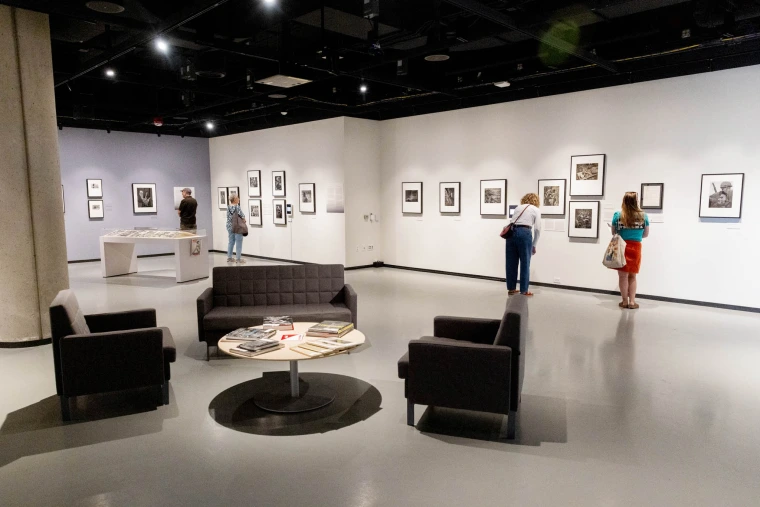‘Refuge and Curiosity’
The Center for Creative Photography broadens its horizon with the Alice Chaiten Baker Interdisciplinary Gallery.

Gallerygoers at the CCP’s Alice Chaiten Baker Interdisciplinary Gallery
Chris Richards photos
They say a picture’s worth a thousand words, but what, in our image-saturated world, is the value of a picture? We talked to Center for Creative Photography Chief Curator Becky Senf about the center’s Alice Chaiten Baker Interdisciplinary Gallery, plans for the CCP’s 50th anniversary and what it means to make a familiar collection feel new.
When the University of Arizona’s Center for Creative Photography opened in June 1975, photography was a relatively new art form; now it’s the one people engage with most, whether they think of it as an art form or not. “Not only do we all do it,” says Becky Senf, “but it has increasingly become a language we use in a standalone way.” The uncaptioned Instagram post, the texted snapshot that instantly conveys a friend’s afternoon: Most people can read an image now, and are in some ways more fluent in them than in the written word.
You might think someone in Senf’s position — chief curator at a gallery and research center for photography — would see it as a moment of crisis, or at least of existential concern. But she seems optimistic. Excited, even. “It’s like [photography] is being multiplied as we watch.”
Last September, the center opened a remarkable retrospective of Tucson-based Chicano photographer Louis Carlos Bernal, whose work captured the domestic worlds of Mexican American communities in the Southwest in ways rarely seen in so-called art photography while also anticipating the way we present ourselves through social media now: casual yet carefully composed, outward facing (check out my stuff!) but cryptic and elusive, too.
In 2021, the center opened the Alice Chaiten Baker Interdisciplinary Gallery and this past year received a $1 million anonymous gift to support programming there. The intent is to create both an independently functioning space and a conversational counterpoint to the main gallery across the hall. Opposite the Bernal exhibition, for example, is a show called “Chicana Photographers LA!,” whose imagery — Sandra de la Loza’s urban archaeology, Amina Cruz’s portraits of queer and trans people of color — feels different from Bernal’s yet shares the effect of showing how Chicano identity can be expressed through art.
‘One of [the] challenges and the rich benefits of collaborative work is that it works best when it happens organically. That takes a lot of planting seeds, having conversations. It takes time. Things have to develop.’
The gallery also has forged collaborations with the university’s Art & Visual Culture Education program for an exhibition about the impact of color on photography (“Why Color?”) and the U of A Laboratory of Tree-Ring Research for a show called “trees stir in their leaves.” The latter in particular showed the way a single subject — trees — could be presented in radically different ways depending on the agenda of the person behind the camera: an interdisciplinary approach. “There was a really beautiful soup of photographs and trees and science and art that played out in the blending,” Senf says.
One of the advantages of the Baker Gallery is that it gives curators like Senf a fresh opportunity to play with what a gallery experience can be. During last year’s Linda McCartney retrospective, for example, the gallery ran “Eight Track,” in which eight local musicians wrote and performed new work inspired by a series of Arizona landscapes projected on the gallery walls. “It was a totally different way of interfacing with the collection,” Senf says. “That kind of freedom and invitation to think creatively, openly, innovatively is very exciting.”
The coming year is still taking shape, but Senf’s got ideas. A history of record-album photography, for example. A show about animals that might involve the School of Animal and Comparative Biomedical Sciences. A look at the intersection between photographic practice and music composition. “One of [the] challenges and the rich benefits of collaborative work is that it works best when it happens organically,” Senf says. “That takes a lot of planting seeds, having conversations. It takes time. Things have to develop” — a photographic metaphor, naturally.
Senf acknowledges that the physical medium of photography — a black-and-white print on a wall — is going to be a hurdle for 18- and 19-year-olds conditioned to seeing images on screens, but therein lies the joy and challenge of her work: “that ongoing process of expanding an audience and making connections,” Senf calls it. In the meantime, the CCP remains one of the best places on campus to spend a free hour. “We want the center’s galleries to be a place of inspiration and dialog and refuge and curiosity,” Senf says. Click.
